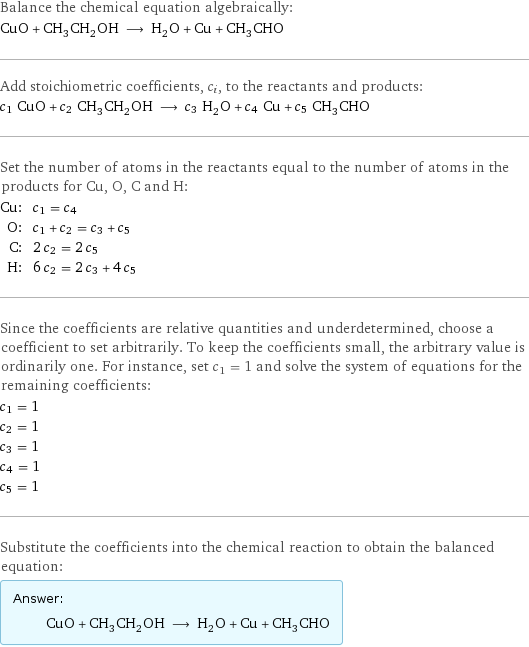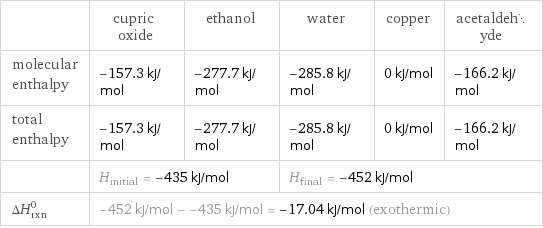Input interpretation

CuO cupric oxide + CH_3CH_2OH ethanol ⟶ H_2O water + Cu copper + CH_3CHO acetaldehyde
Balanced equation

Balance the chemical equation algebraically: CuO + CH_3CH_2OH ⟶ H_2O + Cu + CH_3CHO Add stoichiometric coefficients, c_i, to the reactants and products: c_1 CuO + c_2 CH_3CH_2OH ⟶ c_3 H_2O + c_4 Cu + c_5 CH_3CHO Set the number of atoms in the reactants equal to the number of atoms in the products for Cu, O, C and H: Cu: | c_1 = c_4 O: | c_1 + c_2 = c_3 + c_5 C: | 2 c_2 = 2 c_5 H: | 6 c_2 = 2 c_3 + 4 c_5 Since the coefficients are relative quantities and underdetermined, choose a coefficient to set arbitrarily. To keep the coefficients small, the arbitrary value is ordinarily one. For instance, set c_1 = 1 and solve the system of equations for the remaining coefficients: c_1 = 1 c_2 = 1 c_3 = 1 c_4 = 1 c_5 = 1 Substitute the coefficients into the chemical reaction to obtain the balanced equation: Answer: | | CuO + CH_3CH_2OH ⟶ H_2O + Cu + CH_3CHO
Structures

+ ⟶ + +
Names

cupric oxide + ethanol ⟶ water + copper + acetaldehyde
Reaction thermodynamics
Enthalpy

| cupric oxide | ethanol | water | copper | acetaldehyde molecular enthalpy | -157.3 kJ/mol | -277.7 kJ/mol | -285.8 kJ/mol | 0 kJ/mol | -166.2 kJ/mol total enthalpy | -157.3 kJ/mol | -277.7 kJ/mol | -285.8 kJ/mol | 0 kJ/mol | -166.2 kJ/mol | H_initial = -435 kJ/mol | | H_final = -452 kJ/mol | | ΔH_rxn^0 | -452 kJ/mol - -435 kJ/mol = -17.04 kJ/mol (exothermic) | | | |
Entropy

| cupric oxide | ethanol | water | copper | acetaldehyde molecular entropy | 43 J/(mol K) | 160.7 J/(mol K) | 69.91 J/(mol K) | 33 J/(mol K) | 250 J/(mol K) total entropy | 43 J/(mol K) | 160.7 J/(mol K) | 69.91 J/(mol K) | 33 J/(mol K) | 250 J/(mol K) | S_initial = 203.7 J/(mol K) | | S_final = 352.9 J/(mol K) | | ΔS_rxn^0 | 352.9 J/(mol K) - 203.7 J/(mol K) = 149.2 J/(mol K) (endoentropic) | | | |
Equilibrium constant
![Construct the equilibrium constant, K, expression for: CuO + CH_3CH_2OH ⟶ H_2O + Cu + CH_3CHO Plan: • Balance the chemical equation. • Determine the stoichiometric numbers. • Assemble the activity expression for each chemical species. • Use the activity expressions to build the equilibrium constant expression. Write the balanced chemical equation: CuO + CH_3CH_2OH ⟶ H_2O + Cu + CH_3CHO Assign stoichiometric numbers, ν_i, using the stoichiometric coefficients, c_i, from the balanced chemical equation in the following manner: ν_i = -c_i for reactants and ν_i = c_i for products: chemical species | c_i | ν_i CuO | 1 | -1 CH_3CH_2OH | 1 | -1 H_2O | 1 | 1 Cu | 1 | 1 CH_3CHO | 1 | 1 Assemble the activity expressions accounting for the state of matter and ν_i: chemical species | c_i | ν_i | activity expression CuO | 1 | -1 | ([CuO])^(-1) CH_3CH_2OH | 1 | -1 | ([CH3CH2OH])^(-1) H_2O | 1 | 1 | [H2O] Cu | 1 | 1 | [Cu] CH_3CHO | 1 | 1 | [CH3CHO] The equilibrium constant symbol in the concentration basis is: K_c Mulitply the activity expressions to arrive at the K_c expression: Answer: | | K_c = ([CuO])^(-1) ([CH3CH2OH])^(-1) [H2O] [Cu] [CH3CHO] = ([H2O] [Cu] [CH3CHO])/([CuO] [CH3CH2OH])](../image_source/64495268e00ced4b6dc26397cb20303f.png)
Construct the equilibrium constant, K, expression for: CuO + CH_3CH_2OH ⟶ H_2O + Cu + CH_3CHO Plan: • Balance the chemical equation. • Determine the stoichiometric numbers. • Assemble the activity expression for each chemical species. • Use the activity expressions to build the equilibrium constant expression. Write the balanced chemical equation: CuO + CH_3CH_2OH ⟶ H_2O + Cu + CH_3CHO Assign stoichiometric numbers, ν_i, using the stoichiometric coefficients, c_i, from the balanced chemical equation in the following manner: ν_i = -c_i for reactants and ν_i = c_i for products: chemical species | c_i | ν_i CuO | 1 | -1 CH_3CH_2OH | 1 | -1 H_2O | 1 | 1 Cu | 1 | 1 CH_3CHO | 1 | 1 Assemble the activity expressions accounting for the state of matter and ν_i: chemical species | c_i | ν_i | activity expression CuO | 1 | -1 | ([CuO])^(-1) CH_3CH_2OH | 1 | -1 | ([CH3CH2OH])^(-1) H_2O | 1 | 1 | [H2O] Cu | 1 | 1 | [Cu] CH_3CHO | 1 | 1 | [CH3CHO] The equilibrium constant symbol in the concentration basis is: K_c Mulitply the activity expressions to arrive at the K_c expression: Answer: | | K_c = ([CuO])^(-1) ([CH3CH2OH])^(-1) [H2O] [Cu] [CH3CHO] = ([H2O] [Cu] [CH3CHO])/([CuO] [CH3CH2OH])
Rate of reaction
![Construct the rate of reaction expression for: CuO + CH_3CH_2OH ⟶ H_2O + Cu + CH_3CHO Plan: • Balance the chemical equation. • Determine the stoichiometric numbers. • Assemble the rate term for each chemical species. • Write the rate of reaction expression. Write the balanced chemical equation: CuO + CH_3CH_2OH ⟶ H_2O + Cu + CH_3CHO Assign stoichiometric numbers, ν_i, using the stoichiometric coefficients, c_i, from the balanced chemical equation in the following manner: ν_i = -c_i for reactants and ν_i = c_i for products: chemical species | c_i | ν_i CuO | 1 | -1 CH_3CH_2OH | 1 | -1 H_2O | 1 | 1 Cu | 1 | 1 CH_3CHO | 1 | 1 The rate term for each chemical species, B_i, is 1/ν_i(Δ[B_i])/(Δt) where [B_i] is the amount concentration and t is time: chemical species | c_i | ν_i | rate term CuO | 1 | -1 | -(Δ[CuO])/(Δt) CH_3CH_2OH | 1 | -1 | -(Δ[CH3CH2OH])/(Δt) H_2O | 1 | 1 | (Δ[H2O])/(Δt) Cu | 1 | 1 | (Δ[Cu])/(Δt) CH_3CHO | 1 | 1 | (Δ[CH3CHO])/(Δt) (for infinitesimal rate of change, replace Δ with d) Set the rate terms equal to each other to arrive at the rate expression: Answer: | | rate = -(Δ[CuO])/(Δt) = -(Δ[CH3CH2OH])/(Δt) = (Δ[H2O])/(Δt) = (Δ[Cu])/(Δt) = (Δ[CH3CHO])/(Δt) (assuming constant volume and no accumulation of intermediates or side products)](../image_source/c00e1d177e03b9815ea1e0d31d9bd044.png)
Construct the rate of reaction expression for: CuO + CH_3CH_2OH ⟶ H_2O + Cu + CH_3CHO Plan: • Balance the chemical equation. • Determine the stoichiometric numbers. • Assemble the rate term for each chemical species. • Write the rate of reaction expression. Write the balanced chemical equation: CuO + CH_3CH_2OH ⟶ H_2O + Cu + CH_3CHO Assign stoichiometric numbers, ν_i, using the stoichiometric coefficients, c_i, from the balanced chemical equation in the following manner: ν_i = -c_i for reactants and ν_i = c_i for products: chemical species | c_i | ν_i CuO | 1 | -1 CH_3CH_2OH | 1 | -1 H_2O | 1 | 1 Cu | 1 | 1 CH_3CHO | 1 | 1 The rate term for each chemical species, B_i, is 1/ν_i(Δ[B_i])/(Δt) where [B_i] is the amount concentration and t is time: chemical species | c_i | ν_i | rate term CuO | 1 | -1 | -(Δ[CuO])/(Δt) CH_3CH_2OH | 1 | -1 | -(Δ[CH3CH2OH])/(Δt) H_2O | 1 | 1 | (Δ[H2O])/(Δt) Cu | 1 | 1 | (Δ[Cu])/(Δt) CH_3CHO | 1 | 1 | (Δ[CH3CHO])/(Δt) (for infinitesimal rate of change, replace Δ with d) Set the rate terms equal to each other to arrive at the rate expression: Answer: | | rate = -(Δ[CuO])/(Δt) = -(Δ[CH3CH2OH])/(Δt) = (Δ[H2O])/(Δt) = (Δ[Cu])/(Δt) = (Δ[CH3CHO])/(Δt) (assuming constant volume and no accumulation of intermediates or side products)
Chemical names and formulas

| cupric oxide | ethanol | water | copper | acetaldehyde formula | CuO | CH_3CH_2OH | H_2O | Cu | CH_3CHO Hill formula | CuO | C_2H_6O | H_2O | Cu | C_2H_4O name | cupric oxide | ethanol | water | copper | acetaldehyde